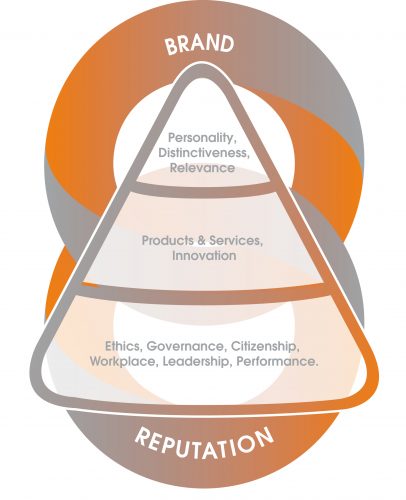
Protect and increase company value with a corporate brand and reputation strategy
Corporate brand and reputation are recognised as being where significant value is held in companies. On average, 90% of the value of a listed company is attributable to intangibles such as brand value and reputation ‘goodwill’. Yet intangible value can be volatile, sensitive to the whims of customers and stakeholders. Brands can lose their way if they don’t remain relevant and credible; reputations can be damaged when companies lose sight of what matters most to customers and stakeholders. Either scenario leading to value destruction.
Thankfully, there is a way to both protect current value and power future value through an effective corporate brand and reputation strategy, following a corporate brand and reputation audit.
Background
As is well known, the shift in the balance of value from tangible to intangible assets in the last few decades has been remarkable. This is also reflected in the explosion of market value versus book value for many new companies, particularly those in tech and the gig economy.
Back in the 1970’s, the value of a FTSE100 company, on average, was made up of 83% tangible and 17% intangible assets. The majority of value held in fixed, tangible assets such as production lines, buildings and bonds. Fast-forward to the 2020’s and that split has reversed. Today, a whopping 90% of company value is in intangible assets such as intellectual property, brands and reputation goodwill.
This shift corresponded with greater volatility in markets where company value can now change quickly and dramatically. This started in the 1980’s first with deregulation then more profoundly with enabling technologies such as mobile ‘phones followed by the internet. This transition has been recognised as a period where market power gradually shifted from that of the corporation (i.e. owners/investors) towards that of stakeholders. So today, single interest groups or well organised stakeholders can exercise huge influence on companies.
A recent report by Booz & Company also found that ‘strategic risks’ presented the greatest threat of value destruction in businesses and the root cause of most strategic risks was a misalignment of stakeholder expectations with company behaviour. The result of this misalignment is what is usually described as a reputation crisis and/or corporate brand damage.
This presents both a risk and an opportunity for companies.
The risk is that market value is vulnerable to the whims of stakeholders, some of whom will be positive and feel they know the company well, others will be distant, possibly hostile, and yet others will be neutral. Do they advocate and support a company and in so doing help drive value? Or are they detractors, removing their support when they disagree or disapprove of the company’s strategy or behaviours and in doing so, destroy value?
Tovera research finds that in some well-known cases where strategic risks became value-destroying reality – such as, for example, at Arcadia Group, Tesco and Deutsche Bank – there had been opportunities to correct the issues that led to the loss of value if only closer attention had been paid to key stakeholders. Risks could have been mitigated and value protected.
So the opportunity resides in the fact that there is room to both protect current value and grow the value of intangible assets (and by extension, future market value) if those stakeholders’ perceptions, expectations and needs could be fully understood and managed. The primary vehicle for this growth is the corporate brand and reputation and the start point is gaining a proper understanding of these assets.
The approach
Tovera has a tried and tested methodology for assessing a company’s brand and reputation (where, as we’ve indicated, the bulk of company value is held).
We start with an assessment of the corporate strategy from a stakeholder perspective – asking what a company is seeking to achieve and which stakeholders it needs on board for the strategy to succeed.
We then identify and engage a sample of those key stakeholders – defined in close consultation with the company – as being the most important to building and maintaining support – in confidential, anonymous, professional in-depth research.
Our corporate brand and reputation experts then analyse findings to provide an assessment of strategic risks and opportunities. This includes an appraisal of the corporate brand and reputation from the perspective of leadership, current strategy and strength of the company’s stakeholder support.
Using this insight we then make recommendations for the overarching brand and reputation strategy. Once agreed by the exec/leadership team we brief the various functions and agencies to ensure all external activities are working together in harmony.
Our findings and strategic recommendations are delivered in a presentation followed by a detailed report providing input to – and even the basis for – a re-focused strategy, CEO preparedness and the evidence-based insight informing strategic recommendations for the supporting corporate brand and reputation strategy.
Our approach includes both strategic advice and the practical steps for a successful implementation/activation across the various marcomms channels.
If you’ve read this far and would like to hear more, our managing partners – Spencer Fox and Ann Binnie – are willing to provide an initial assessment of your corporate brand and reputation opportunity on a one hour introductory call (Teams/Zoom etc.) with no obligation to commit to a project.
Use the contact form to get in touch.

